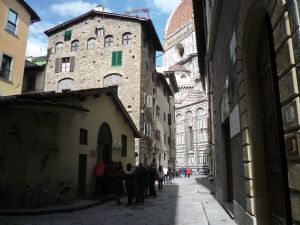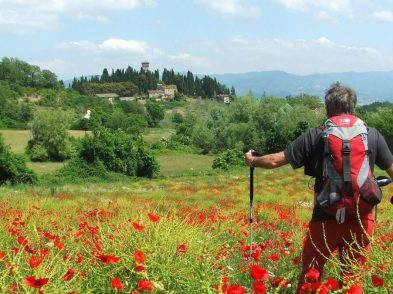It’s late summer, unseasonably hot, and I’m amidst the clamoring crowds walking toward Ponte Vecchio on via Por Santa Maria. It’s dusk, and for some reason the sun seems to strike harder upon going down. I need a refuge. Instead of following the map-wielding, chatty crowds, I take a right on Borgo Santissimi Apostoli for sanctuary.
It’s dark and quiet-and, best of all, cool. The late light cuts a slant into this narrow medieval street, and I watch the sun glinting off willow seeds floating in the air. My meditative moment is quickly crushed, however, when I slap my arm to kill a blood-sucking creature-the zanzara (mosquito).
I keep walking and come upon the towering Gallery Hotel Art on my left, its entrance on the adjacent Vicolo dell’ Oro. Because the viccolo is rather wide, the sun pours light on the hotel’s modern pristine ivory façade. The Ferragamo family created this hotel in 1999 and, perhaps as a tribute to history, left elements of the fifteenth-century stonework of the palazzo underneath.
On the side of the Gallery Hotel facing Borgo S.S. Apostoli are large windows with only plain white panels. I wonder what’s inside. A large, medieval door suddenly opens and a young woman pops out for a cigarette. ‘Che cosa fai di bello?’ she shouts into her cell phone. I cross the street and soon hear a rumbling behind me. I jump to the sidewalk (and these sidewalks do seem unjustifiably narrow) just in time to avoid being hit by one of those orange minibuses that operate only in the city center.
Where is my peace?
I happen to come right up to the Buondelmonti Tower (no. 10). Though this twelfth-century tower was first home to the family of the same name, it was later occupied in the fourteenth century by the Acciaiuoli, a powerful banking family of Florence. This tower is one of the tallest left in Florence.
The Palazzo Acciaiuoli is attached, but the one the family was most well known for used to sit right on the Arno, across the street. Unfortunately, this palazzo was lost in 1944 when a German mine exploded. The name of this stretch along the river is Lungarno Acciaiuoli.
Today within the tower (no. 18/R) is a shop called Infinity Leather, and in the palace next door (no. 8) is the posh Hotel Torre Guelfa.
Just as I’m bemoaning the idea that historical monuments in Florence are sold out for cold commerce, I hit upon the sounds of chatter and clinking wine glasses at Mangiafoco Café (26/R), a wine bar that, at 7 in the evening, is fairly packed. For a street that seems so far otherwise a little stuffy and dark, it’s refreshing to see Mangiafoco’s playful orange, fuscia and violet sign and to sense something festive in the air.
I move on, the music fading.away, when a vista of green opens up to my right-a lush garden behind gates,
with no name or no explanation. There is a lovely white sculpture of a man’s head above the arched doorway, but that is all.
Just next door to the garden is the haute couture jewelry shop, Angela Caputi. The window display is fantastic: tropical leaves surround two green chairs. On each chair sits a large purse stuffed with bright, colorful scarves: one purse is blue, the other red. Handcrafted jewelry drapes over a bed of leaves below the chairs. In the next window, brightly colored necklaces are slung over a canary yellow chair that is tipped precariously. It’s a gorgeous ensemble.
I am now standing opposite the famous Piazza del Limbo, that precious, sunken-in piazza that boasts the Chiesa dei Santi Apostoli. But before I descend, I take in the nineteenth-century building on my side of the street, the Bagni nelle Antiche Terme, which stands on the site of the original Roman baths. Antonio Peppini funded the construction of this building in 1826 (his name adorns the building) to be used once again for the city’s public baths. It is now a high-end tailor shop, Bottega delle Antiche Terme di Simone Abbarchi (no. 16).
Finally, I step into the piazza.
This piazza is the heart of Borgo Santissimi Apostoli. Here lies the reason for the name of the street: the Chiesa di Santi Apostoli is dedicated to Saints Peter and Paul. The source of the name of the Piazza del Limbo is quite dark: underneath is the former graveyard site for unbaptized babies-hence they are in spiritual ‘limbo.’
The Romanesque church is one of the oldest in Florence: it dates to 1075. It is also one of the most beautiful. Brunelleschi is said to have been inspired to create Santo Spirito after visiting this chiesa. A plaque just outside claims that Charlemagne founded this church, but no records confirming this have been found.
Just across the square, the glass doors and gold logo of the modern Hotel Berchielli (no. 6/R) contrast with the church’s eleventh-century church façade. Straight ahead is a narrow walkway to Lungarno Acciaiuoli that oddly resembles the shape of a keyhole.
Near the walkway is a marker noting the area’s high-water line for the 1966 flood. Because the piazza is sunken, it was particularly vulnerable to the ravages of the flood, and the church and its masterpieces inside did not escape damage. Thankfully, much has survived.
It is darker now, and I ascend out of limbo to continue my walk down the street. A colorful doorway up ahead,
overflowing with baskets of fruits, vegetables, and flowers, immediately catches my eye. The doorway is loaded with everything from oranges to spinach to lilacs. The shop, Frutti e Ortaggi, was founded in 1934, and therefore it is a negozio storico. The shop’s owner, Sandra Fancelli, decorates the storefront every day. Like Mangiafoco, it is a wonderful scene to come upon; the rich, vibrant colors of the fruits and vegetables liven up this quite dusky medieval street.
I take the turn in the road that opens onto Piazza della Trinità, and the noise of the city slowly returns. The
aroma of meat and garlic wafts from the open door to the busy kitchen of Trattoria Carrozze. Motorbikes buzz and buses squeal on via de’ Tornabuoni. As I return to the crowds, I reflect that living in Florence is always a combination of busy, loud, and intense energy, punctuated by brief, meditative moments, taken by
surprise. There is no escape, after all, because at any second the energy can shift; to enjoy the quiet is the same as enjoying the intensity-it’s all one.
And likewise, the city’s startlingly vibrant colors-a bright red scarf in a window, a burst of purple lilacs at a shop-only stand out because they are set against the simple, grey stonework of a palazzo.
I enter the fray once again, a little more at peace.







